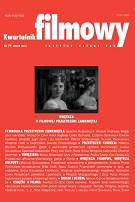Prostota i naturalność. Przestrzeń prywatna i przestrzeń publiczna w filmach Mizoguchiego i Ozu.
Simplicity and naturalness. private space and public space in films of Mizoguchi and Ozu.
Author(s): Krzysztof LoskaSubject(s): Theatre, Dance, Performing Arts
Published by: Instytut Sztuki Polskiej Akademii Nauk
Keywords: Mizoguchi; Kenji; Ozu; Yasujirō; "Late Spring" (1949); "A Story of Floating Weeds" (1934); "Tokyo Twilight" (1957); "Story of the Late Chrysanthemums" (1939); "Miss Oyu" (1951 ); mise en scėne; specific interior design.
Summary/Abstract: The author focuses on the work of Kenji Mizoguchi and Yasujirō Ozu, taking up the issue of mise en scėne. He notes that the specific interior design, characterised by refined simplicity so different from European interiors, is a factor determining the nature of the movie image in the works of both of these directors. This applies both to private and public spaces. In his discussion Loska abstracts from stereotypical notions of Orientalism, and tracks the presence of certain principles of mise en scėne in the structuring methods and compositions of the movie frame, that are to some extent conditioned by the stage design and iconography. Loska analyses these issues using the following films as examples: "Late Spring" ("Banshun", 1949), "A Story of Floating Weeds" ("Ukigusa monogatari", 1934) and "Tokyo Twilight" ("Tōkyō boshoku", 1957) by Ozu and "Story of the Late Chrysanthemums" ("Zangiku monogatari", 1939) and "Miss Oyu" ("Ōyu sama", 1951 ) by Mizoguchi. Loska argues that the search for simplicity and nature present in these films reflects deeper philosophical and moral principles that govern Japanese society. According to Loska both directors use architecture not only in order to refer to tradition, but also as an element of frame design.
Journal: Kwartalnik Filmowy
- Issue Year: 2012
- Issue No: 79
- Page Range: 192-200
- Page Count: 9
- Language: Polish

